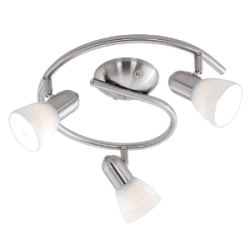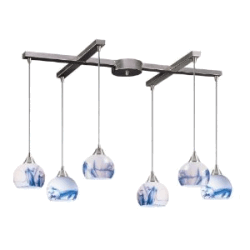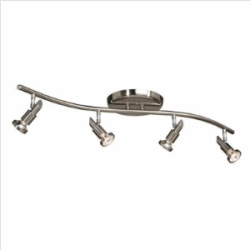Modern Track Lighting: Contemporary Styles and Fixtures
Modern track lighting blends new options in tracks and fixtures.
In a sense, all track lighting is modern track lighting (in fact, in a sense, all lighting is modern). Track lighting only has been used commonly since the Second World War. However, in the last few decades, there have been a number of significant changes in the style of track lighting, so much so that current styles are almost unrecognizable in some cases. In this article, I will discuss those options, providing information about some of the most important changes in track lighting over the last thirty years.
Track Changes

Modern tracks often become completely decorative, such as in this model available on Amazon.
Track lighting was originally designed for museums, art galleries and other spaces that required flexible accent lighting. It was, not surprisingly, highly functional. Lights were designed to be easily shifted along the tracks and pointed in different directions, so that artwork and other works of interested could be easily lit from show to show. The result was that the tracks and fixtures themselves were, well, boring. They were not intended to be looked at, and it took a while for track lighting to move into the home.
Once they did move into the home, however, track lighting shifted significantly. The tracks themselves even changed. Instead of the standard straight tracks that you would move halogen fixtures across, home owners are now presented with a wide range of options. These options include immovable, curved and vertical tracks, none of which had been used before.
Immovable Fixtures
As the historical purpose of track lighting was to provide flexible lighting, it is somewhat surprising that one of the primary changes in modern track lighting has been to shift to immovable fixtures.
There are two reasons for this change. First, having several fixtures on a single track enables people to have four or more fixtures that are connected to the ceiling at only a single electrical source. This spreads out the sources of light while minimizing the amount of installation required. In fact, many immovable track fixtures only connect to the ceiling at a single point.
The second reason was to provide more options in the appearance of the track itself. At the end of the day, having tracks on which it was possible to move around fixtures limits the styles of track. Not being concerned with mobility allows for tracks that twist and bend in awkward ways. Form takes precedence over function.

Two common contemporary styles are pendant fixtures and immoveable fixtures. This model is available at Amazon.
Curved Tracks
Another important development in modern track lighting is the development of curved track lighting. These tracks, unlike the immovable fixtures mentioned above, still allow you to move the fixtures along the track. However, the track is designed in such a way that they curve along the ceiling, allowing you to follow more complex room contours or just look more stylish.
Curved tracks come in two different types. There is standard, inflexible curved lighting that is usually in modular pieces that can be fit together in different shapes. There is also what is called “flex track lighting”, which can be bent into whichever shape that you wish. This flexible track lighting provides you with the option of using your track itself in clever and decorative ways.
Vertical Tracks
One fun option introduced by certain types of flexible track lighting is the possibility of vertical changes in your tracks. Historically, tracks for track lighting have always been strictly horizontal, even for curved tracks. However, there are now tracks available that will slowly slant downwards or upwards. This allows you to have a new level of control over the appearance of your decorative tracks, allowing you to use spirals, slopes on irregular ceilings or whatever fits your imagination.
Changes in Modern Track Lighting Fixtures
Modern track lighting fixtures have changed significantly, far more so than even the tracks. Until twenty years ago, there was really only one form of track lighting: directed, halogen accent lighting. However, lighting designers quickly discovered that they could place any low-voltage fixture they wished on the tracks and, given the new flexibility of the tracks, in just about any position that they wish.
Pendant Fixtures
One of the most common types of modern track lighting are pendant fixtures. Rather than use the tracks solely for accent lighting, these fixtures completely changed the function of tracks themselves. By using a track, one can hang numerous pendants across your living space in a straight or curved line.
This provides numerous advantages over other forms of lighting. Unlike standard pendant lighting, the light is not centralized in a single spot, which can create a harsh “glare bomb” that hurts the eyes. Instead, the light shines from numerous spots. Unlike accent lighting, the light provides softer, ambient lighting that spreads easily throughout the entire room. Finally, unlike recessed lighting, the light does not shine straight downwards, cutting down on harsh shadows that accentuate wrinkles and ages those in the room.
In addition, these pendant fixtures can be really quite attractive. Because there are multiple pendants, they tend to be much smaller, providing decoration without attracting too much attention. Think of them like a few smaller trinkets on your shelf rather than one big one, providing overall decorative accents.
Stylish Accent Lighting
Of course, modern track lighting is still often used for accent lighting. It is still the most flexible lighting available. However, the style of the accent lights themselves has changed so that they are not the industrial eyesore that one might expect in a museum or gallery.

Accent lighting has become more fluid-looking, blending curves and specular surfaces. This model is available at Amazon.
Many track lights are now made out of an attractive chrome finish, where the original functional appearance of the fixture is maintained, but the fixture itself is beatified through the use of more geometric shapes and through more specular surfaces (surfaces that reflect images well). With the recent increased use of LED light fixtures, accent lighting may be flatter, leading to functional-appearing lights that look more like discs than like the traditional cone shape.
An interesting mix of the new styles in pendant lighting and accent lighting is the inclusion of a PAR or parabolic, directed light bulb inside of a fixture that would otherwise look like a pendant. These fixtures can be directed and shone in different directions, but completely lose their functional appearance in place of the more decorative appearance of pendant lights. I have a caution about this, though: to use these lights properly as accents, you will have pendants that aren’t actually hanging downwards. Some people find that this looks a bit strange, so choose these according to taste.
Putting It All Together
Modern track lighting has completely changed the overall style and functionality of track lighting:
- Tracks themselves have now become an object of decoration, including various types of fixed, curved and even vertical tracks.
- Pendant track lighting has completely changed the functionality of contemporary track lighting, allowing you to create soft, even, multi-directional lighting for your room.
- Accent track lighting has become sleeker and more attractive, using new materials and geometric shapes.
Modern track lighting, therefore, can provide a number of different functions in your home lighting design.